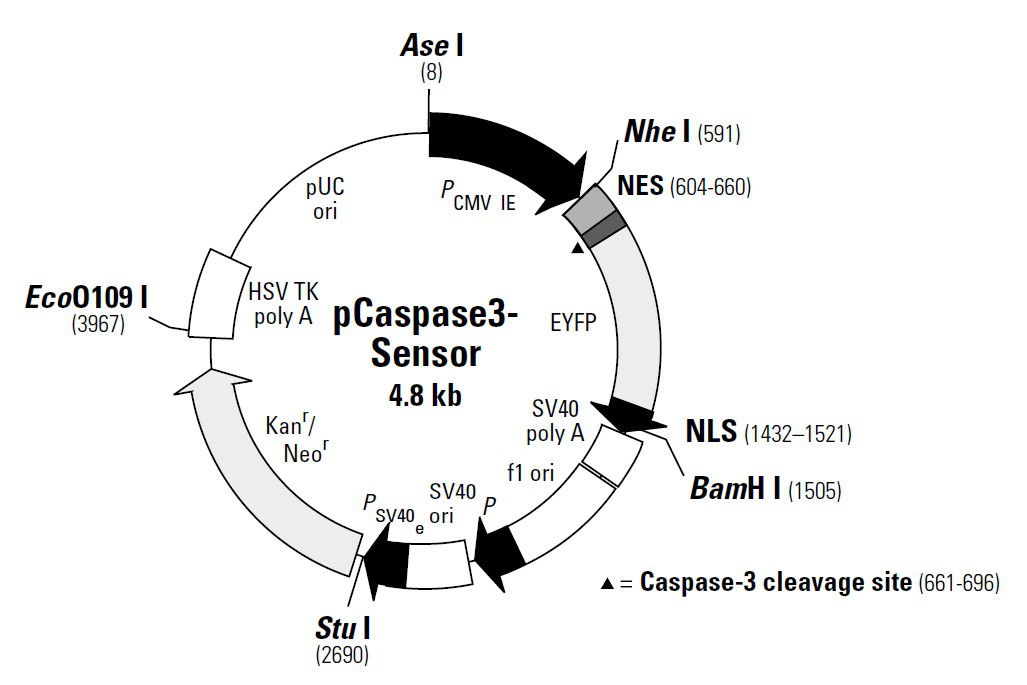■ 基本信息
启动子: | CMV |
复制子: | pUC |
原核抗性: | Kan |
真核抗性: | G418 |
克隆菌株: | DH5a |
培养条件: | 37度 |
■ 质粒属性
质粒宿主: | 哺乳细胞 |
质粒用途: | 信号报告 |
片段类型: |
|
片段物种: |
|
原核抗性: | Kan |
真核抗性: | G418
|
荧光标记: |
|
■ 质粒简介
pCaspase3-sensor是一个哺乳细胞黄色荧光蛋白信号通路报告质粒。pCaspase3-Sensor Vector can be used to detect the onset of caspase-3 activity in mammalian cells. This vector encodes the enhanced yellow-green variant (EYFP) of the Aequorea victoria green fluorescent protein (GFP) fused at the 3' end to three copies of the nuclear localization signal (NLS) of the simian virus 40 large T-antigen (1,2). At the 5' end the gene contains a sequence encoding the nuclear export signal (NES) of the Map Kinase Kinase (MAPKK;3). The NES is separated from the EYFP coding region by a 36-nucleotide sequence encoding the region of Poly (ADP-ribose) polymerase (PARP) cleaved by caspase-3. The complete coding sequence for this fusion protein is human codon-optimized (4). Because the NES of MAPKK dominates the NLS, the full-length fluorescent fusion protein distributes to the cytosol. If caspase-3 is activated, the NES will be cleaved from the fusion protein and the truncated EYFP-NLS fusion will translocate to the nucleus via the NLS. The translocation of the fluorescent protein from the cytosol to the nucleus indicates caspase-3 activity at a cellular level. The fluorescence excitation maximum of EYFP is 513 nm; the emission spectrum has a peak at 527 nm (in the yellow-green region). The Em of EYFP at 513 nm is 36,500 cm–1M–1 and its quantum yield is 0.63 (5), resulting in a bright fluorescent signal. The fluorescence intensity is roughly equivalent to that of EGFP.
The vector contains an SV40 origin of replication and a neomycin resistance (Neor) gene for selection (using G418) in eukaryotic cells. A bacterial promoter (P) upstream of Neor expresses kanamycin resistance in E. coli. The vector backbone also provides a pUC19 origin of replication for propagation in E. coli and an f1 origin for single-stranded DNA production.
The pCaspase3-Sensor Vector can be introduced into mammalian cells using any standard transfection method. If desired, stable transfectants can be selected using G418 (6).pCaspase3-Sensor can be used to detect the onset of caspase-3 activity in mammalian cells. This vector allows visual monitoring of caspase-3 activity in the cell via fluorescence microscopy. If the fluorescent fusion protein encoded by the pCaspase3-Sensor vector is in the cytosol, caspase-3 is not active. However, if caspase-3 becomes active, the dominant nuclear export signal (NES) is cleaved from the fusion protein and the truncated fluorescent protein will become localized to the nucleus via the nuclear localization signal.
■ 质粒图谱




